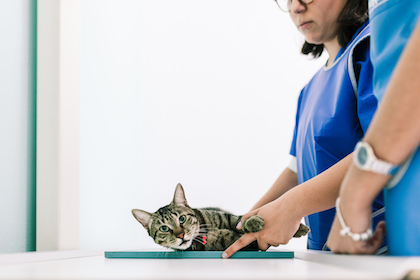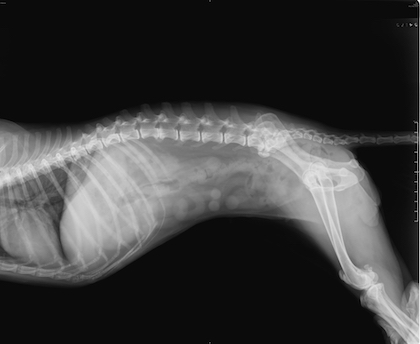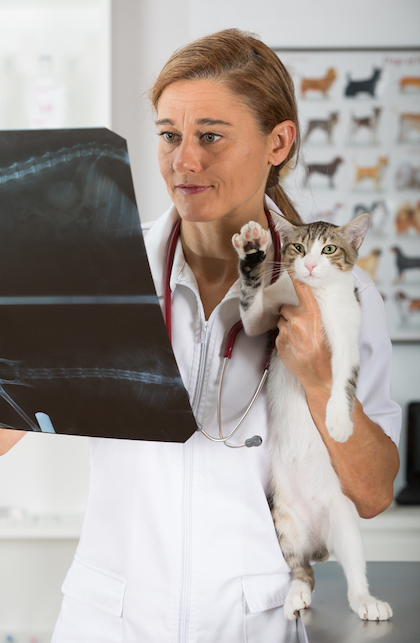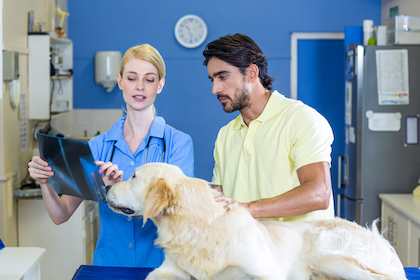Pet Insurance Review > Pet Wellness Guides > How to Save Money on Pet X-Rays - Pet Insurance Review
How to Save Money on Pet X-Rays
Posted: 05/30/2022 | BY: Erin Cain | Categories: Health problems , Pet care , Top Tips , Vets
If you’re a pet parent, then you know that veterinary care can be expensive. One of the most common veterinary procedures is an x-ray, which can cost anywhere from $75 to $500, depending on various circumstances. However, there are ways to save money on pet x-rays. In this article, we will discuss some tips for reducing the price of this procedure.

Reasons pets may need an x-ray.
Going to the vet is usually an expensive process. Still, anytime your veterinarian mentions X-rays, it’ll cost you a little more.
X-rays are often the most effective way for vets to diagnose injuries and illnesses in animals. However, they can be quite costly, pricing between $75 – $500 depending on several factors, such as where you live or whether your pet requires higher-level scans. X-rays are an essential part of caring for your furry friend. They can help detect any medical problems early on when it’s easier for your vet to treat them. X-rays can also allow a vet to decide on surgery right away to prevent long-term complications from developing into something much worse.
We’ll talk about factors contributing to the wide range of x-ray prices listed above and ways to save costs on this pricey procedure. First, let’s discuss why your dog or cat might need X-ray services.

Ingested foreign object
If your dog or cat ingests a foreign item, it can cause serious medical problems. Vets may order X-rays to determine where the object is located in the pet’s body. Sometimes, swallowed things will not show up on an X-ray because they don’t emit enough radiation to penetrate the object’s surface. Your vet will search the x-ray for evidence of trapped air or other signs of a swallowed object to help determine where in the digestive system it is located.
The vet will then devise a treatment strategy and, if necessary, perform surgery to remove whatever your pet swallowed.
Cancer
X-rays offer a valuable way to investigate some types of potentially cancerous tumors. They can effectively identify the disease, but not all forms show on film. Some cancers blend into surrounding tissues, making them difficult or impossible to diagnose through this means alone. However, vets still rely heavily upon x-ray examinations when cancer is suspected. It allows direct access to an animal’s body, where other techniques cannot go without risk.
Orthopedic conditions
Hip dysplasia is the most common cause of lameness in dogs. The hip joint comprises bones that act as a ball and socket. Sometimes, when they don’t fit properly or rub against each other, it can cause deterioration in the bone which will eventually result in limited to no function in the joints.
An x-ray can determine if your pup has this condition, which often occurs when there’s damage to their hip socket. Your vet will be able to see if your dog’s hips are in the proper position with an X-ray. If they diagnose hip dysplasia, the orthopedic expert can determine how severe it seems by viewing pictures of their patient’s bones and muscles during the examination.
Arthritis is usually a result of hip dysplasia. Like that common canine condition, it can only be diagnosed with an x-ray. The vet will look for signs of degeneration in the joints on the film to determine the level of arthritis present and the best course of treatment for the dog.

Stones
For pets with stones– whether bladder, gallbladder, or kidney– x-rays are crucial to identify the stones in question. These stones show up reasonably clearly on x-rays, making them easy for a veterinarian to spot on the film. Your vet will be able to take care of removing the stones, if necessary, without having any trouble finding them. X-rays also let the vet determine whether the stones can be allowed to pass naturally or not.
Broken bones
When a vet suspects that your cat or dog has suffered an injury to their bone, they will likely order X-rays. The images provided by this technique allow the veterinary staff a visual inspection of how much damage there might be before determining treatment options, such as casting or surgery.
Heart or lung disease
If your dog is frequently coughing, especially when lying on his side, and you’re concerned about heart or lung disease, it might be best to take him away for vet care. X-rays are an excellent way for your vet to look at the size of your pet’s heart, whether or not their lungs are clear, and what tracheal diameter your pet has.
Senior pets are at risk for many age-related health issues, including heart and lung problems. To protect your aging pet from these diseases or other unforeseen circumstances, they must go in for regular checkups and x-ray imaging.
Surgical follow-up
Pets often need an x-ray after they’ve had surgery so that the vet can inspect their work and make sure everything is healing correctly. If, for example, a pet has a broken bone, the vet must visualize how everything lines up so that they can fix it properly.

What does the average x-ray cost?
X-rays range in price from $75 – $500, depending on various factors. By considering the factors listed below, you may be able to determine whether or not your dog’s X-rays will be more expensive than expected.
Geographic location
The cost to take your pet to the vet for x-rays will vary depending on where you go. A large veterinary clinic will likely be more expensive than a small town veterinary hospital. The income levels of a geographic location also impact the price of veterinary x-rays; in an area with high median incomes, the costs will be higher for x-rays than in an area of average to below-average incomes.
Emergency services
If you take your pet to an emergency clinic, the charge will be higher than if a vet sees them in a traditional animal clinic. The price range can vary based on what type of injury the pet has sustained and how many medical x-rays are needed for evaluation. With a price of $75 – $500 per x-ray, the film for a pet who requires multiple x-rays could run upwards of thousands of dollars.
Injury location
Where a pet’s injury is located also impacts x-ray costs. It’s easier to x-ray the lower leg, foot, or paw of a pet because there isn’t much involved in these areas that can obscure an image. Vets cannot say the same when it comes to trickier body parts, like the tail or head. Those body areas are more challenging to maneuver on the x-ray machine. Often, these cases require multiple x-rays, which means higher costs for pet parents.
Sedation
A pet needs to stay still for x-ray imaging, which is why sedation is often given to the pet to make them easier to maneuver for the procedure. Although some pets can remain motionless, most have difficulty doing so if they are in pain or anxious.
Your vet will likely sedate your dog or cat to calm them down and keep them still so that the vet can take an X-ray without the animal moving around. Sedation substantially raises the price of an x-ray. Still, there isn’t much you can do when it’s necessary for medical attention.
Pet size
The size of your pet also dictates the price of x-rays. A single x-ray for a small dog, like a Maltese, may be all that’s required to diagnose a medical issue. However, larger breeds, like Newfoundlands or German Shepherds, often require multiple x-rays, so the vet can get a complete look at what is happening internally with the dog.
Specialized equipment
X-ray equipment is multi-layered and expensive. The equipment used for this procedure includes the x-ray machine and special computer programs and computer processing that run during the x-ray procedures. Depending on a veterinary practice’s budget and needs, there is a range of machines to choose from, and none of them are cheap. With costs ranging between $6000 – $57,000, it’s understandable that the clinic will pass down some portion of the machine’s fees to the pet owner.
It’s important to remember that those are not only the costs associated with using an x-ray machine. Veterinary technicians must be trained to use the device. They require protective equipment for a radiation dose that is effective and efficient against radiation exposure. All of this specialized equipment requires regular maintenance to keep it running, a need that is not cheap for your vet’s office.

Tips for saving money on x-ray imaging
While there’s no denying that x-rays are expensive for various reasons, there are a few ways to save money. Here are some steps to take that can reduce the damage to your budget:
Pet insurance
Pet x-rays can be expensive, but pet insurance can make it easier by reimbursing pet owners for at least 70% of the bill. Many pet insurance providers offer moderate to full coverage of x-ray procedures. That means you will have support covering a portion or possibly all the x-ray costs.
Please note that most pet insurance policies have a waiting period before they become active, so you’ll need to obtain one well before needing it. That’s why it’s always a good idea to secure an insurance policy for your pet before they need it.
Wellness programs
Separate from formal pet insurance policies, wellness plans cover expected and unexpected trips to your veterinary clinic. Some pet insurance companies offer wellness plans as an additional rider to the policy itself. The best pet wellness plans cover prevention and treatment for standard procedures like x-rays and treatments for ailments such as cancer, allergies, or food sensitivities.
Locate a teaching hospital
Many colleges with established veterinary programs operate teaching clinics or hospitals where students can learn about veterinary medicine in an educational setting with professional supervision. The prices for x-ray procedures at these clinics are often much lower than in conventional veterinary offices and hospitals. Contact veterinary teaching hospitals near your location to determine what they charge for x-ray procedures.
Pet insurance helps with x-ray costs.
When choosing a pet insurance plan for your furry friend, there are many things to consider. You want one that will give you peace of mind while also providing your pet with top-of-the-line care and treatments, such as x-rays. Depending on your choice of policy, your pet insurance provider will cover at least a portion of the price of your pet’s x-rays. That way, your pet gets the care they need, and you don’t have to worry about how the bill will impact your finances.
Let Pet Insurance Review find the right policy for you and your pet, so you can start saving money. Get a free quote today to ensure your pet is protected no matter what happens tomorrow.
References:
- Emergency Vet 24/7. (2020). How Much Does a Dog X-Ray Cost? Retrieved from https://emergencyvet247.com/dog-x-ray-cost/
- Arizona Veterinary Oncology. (2020). Soft Tissue Sarcoma in Pets. Retrieved from https://www.arizonaveterinaryoncology.com/pet-cancer-types/pet-soft-tissue-sarcoma
- Best Friends Animal Hospital. (2022). Hip Dysplasia — PennHIP and OFA Radiographs. Retrieved from https://bfah.net/hip-dysplasia-pennhip-and-ofa-radiographs/
- Kingsdale Animal Hospital. (2022). Bladder Stones in Dogs And Cats. Retrieved from https://www.kingsdale.com/bladder-stones-in-dogs-and-cats
- Cardiac Care for Pets. (2022). Pet Diagnostic Tests. Retrieved from https://www.cvcavets.com/for-pet-owners/diagnostics/
- Pet Pro Supply Co. (2022). Veterinary X-Ray Machines. Retrieved from https://www.petprosupplyco.com/collections/veterinary-x-rays
- U.S. Veterinary Teaching Hospital. (n.d.). U.S. Veterinary Teaching Hospital. Retrieved from https://www.petpigs.com/wp-content/uploads/2011/06/US-Veterinary-Teaching-Hospitals.pdf
The information contained on this blog is intended for informational and educational purposes only and should not be construed as medical advice. It is not a substitute for professional veterinary care. Always consult with your veterinarian before making any changes to your pet's health care or treatment plan.
The authors of this blog are not veterinarians and do not claim to be experts in pet health. The information provided here is based on our own experiences and research, as well as information from reputable sources. However, we cannot guarantee the accuracy or completeness of this information.
We encourage you to do your own research and consult with your veterinarian before making any decisions about your pet's health.